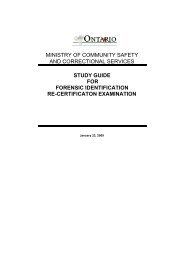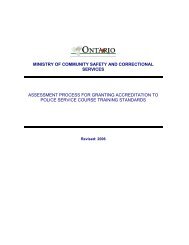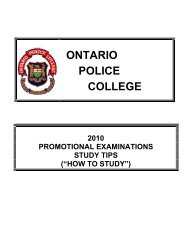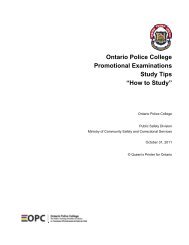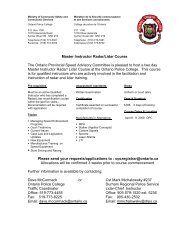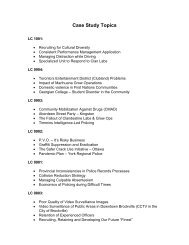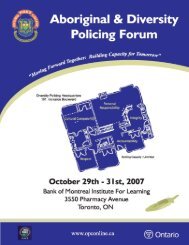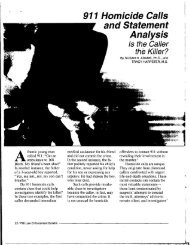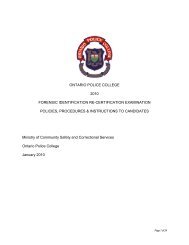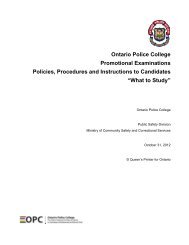General Study Guide - Ontario Police College
General Study Guide - Ontario Police College
General Study Guide - Ontario Police College
You also want an ePaper? Increase the reach of your titles
YUMPU automatically turns print PDFs into web optimized ePapers that Google loves.
Procedures for conducting an examination:<br />
Conduct an examination in a dark room<br />
Aim expanded beam of light at object<br />
View object through an orange barrier or other appropriate coloured filter<br />
Preserve latent prints by photography<br />
The ability to detect fingerprints by fluorescence is dependent on three principal factors:<br />
1. The illuminating wavelength (or Excitation filter) must be appropriate to provide maximum<br />
fluorescence contrast between the fingerprint and the background; i.e. the correct<br />
wavelengths must be available for the chemicals involved, and there must be no significant<br />
stray light at the wavelengths at which the fluorescence is being viewed.<br />
2. Viewing or Barrier Filters include filters for goggles*, viewing housings and cameras (which<br />
must be selected for the chosen excitation filter before allowing light to be emitted from the<br />
forensic light source). The viewing filter must be suitable for protecting the eyes against the<br />
incident radiation, transmit the fluorescence, and where appropriate, separate the<br />
background and fingerprint fluorescence. It will completely block the excitation light, while<br />
allowing as much of the fluorescent emission through as possible.<br />
3. The system must produce an intensity of illumination at the surface high enough to produce<br />
sufficient fluorescence to be effectively observed and photographed.<br />
TYPES OF FLUORESCENCE EXAMINATION:<br />
Fluorescence examination may be used in two principal ways:<br />
As part of an initial examination procedure after a visual examination with white light; and<br />
As an enhancement technique after the application of certain development techniques.<br />
Initial Fluorescence Examination:<br />
With a laser or forensic light source, an initial examination of an exhibit can be carried<br />
out to look for inherent fingerprint fluorescence.<br />
It is frequently unsuccessful<br />
In some cases fingerprints appear darker than the surrounding surface. <strong>General</strong>ly this<br />
occurs when the fingerprint is contaminated with a material, such as blood, which<br />
absorbs the incident radiation and when the background is a material which fluoresces<br />
under the wavelength being used.<br />
<strong>General</strong>ly the operator has no way of knowing what the fluorescent materials are, and<br />
therefore no indication of which combination of excitation wavelength and viewing filter<br />
is going to be most effective.<br />
Experience with different surfaces, types of scenes and excitation and emission<br />
wavelengths will provide better guidance in the future, if comprehensive records are<br />
kept of all examinations, successful or otherwise.



